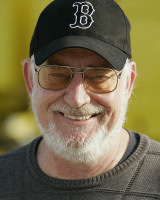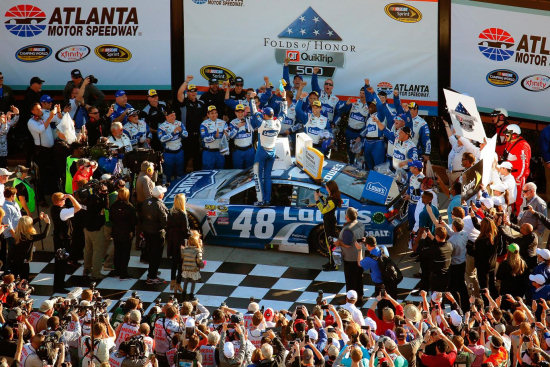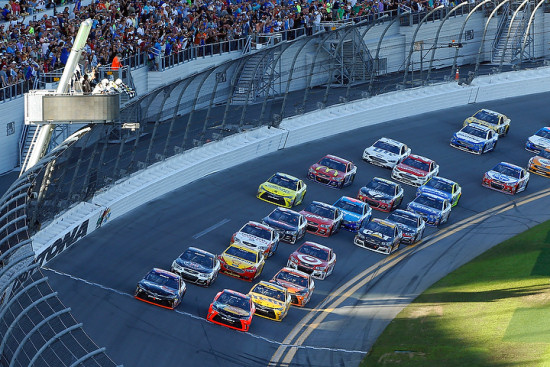The Way It Is/ NASCAR's strengths and weaknessesby Gordon Kirby |
 Daytona provided a feel-good start to NASCAR's season with the track's closest-ever photo finish, a new 500 winner in Denny Hamlin and rave reviews from many people for the 'Daytona Rising' re-invention. Hamlin has shown plenty of race-winning speed in recent years with Joe Gibbs's Toyota team. This is his eleventh season of Sprint Cup racing with Gibbs and after a series of ups and downs he may at last be hitting his stride.
Daytona provided a feel-good start to NASCAR's season with the track's closest-ever photo finish, a new 500 winner in Denny Hamlin and rave reviews from many people for the 'Daytona Rising' re-invention. Hamlin has shown plenty of race-winning speed in recent years with Joe Gibbs's Toyota team. This is his eleventh season of Sprint Cup racing with Gibbs and after a series of ups and downs he may at last be hitting his stride.
Through last year's closing stages the Gibbs Toyotas often were the class of the field with plenty of horsepower and good-handling cars. Each of Hamlin, Matt Kenseth, Carl Edwards and Kyle Busch were frontrunners in most races, winning 13 races between then, and it was no surprise that Busch was able to bounce back from breaking his leg at the beginning of the season to win his first Cup championship. At Daytona all four Gibbs Toyotas ran well as did Martin Truex's satellite Furniture Row car. The five Toyotas combined to lead 156 of 200 laps but it was a different story at Atlanta last weekend. Kevin Harvick led most of the race but Jimmie Johnson used sharp pit strategy to take the lead and go on to score the 76th win of his career, thus equaling the great Dale Earnhardt's tally of wins. Big news in NASCAR last week was the announcement of Stewart-Haas's surprising switch to Ford next year. Stewart-Haas has raced Hendrick Chevrolet cars and engines since its start in 2009, adding strength to Chevy's overall assault and winning two championships with Tony Stewart in 2011 and Kevin Harvick in 2014. The team's move to Ford should improve the blue oval company's chances of winning in NASCAR and may help the struggling Roush Fenway team find a way back to the front.  © Atlanta motor Speedway/Getty Images Meanwhile, Tony Stewart and Gene Haas started talking to Ford six months ago. Stewart commented on his team's change of manufacturers. "I think more than anything once we got in conversations with Ford it was the resources that we learned we would have access to is what really intrigued us," Stewart said. "I think the one thing that really caught our attention was how dedicated they are and the amount of resources that they're willing to put forth to help us all accomplish the goal that both sides want to accomplish in all this. That was very impressive. "The technology layer is huge. I feel like they're giving us something that we really need right now that's going to help us down the road. That was really a huge factor in making this decision. "We're trying to do everything we can to try to be as self-sufficient as we can going into 2017," Stewart added. "We're going to add a lot of personnel to our organization to do our own chassis program and we're excited about it. We see this as a lot of growth for Stewart-Haas Racing. "It's not just changing OEMs, it's a great opportunity for us to kind of get out of the shadows and, to some degree, get off the coattails to a certain degree, and really get out on our own. I think that's something everybody at SHR is really excited about and proud that we're finally in a position to do this and branch out in this way." Stewart-Haas's move to Ford emphasizes the deep commitment to NASCAR from each of Ford, Chevrolet and Toyota. And of course, maintaining successful working partnerships with the manufacturers has always been among NASCAR's greatest strengths. Another key element in NASCAR's overall health is the well-defined and established ladder system the organization has built over many decades. NASCAR is miles ahead of IndyCar in enjoying a ladder system with viable commercial support which enables young stars to rise from local short track racing to Trucks, the Xfinity series and finally the premier Cup level.  © LAT USA As a result of a thriving ladder system NASCAR is currently enjoying a flush of talented rookies and up and comers. In the past few years Kyle Larson and the Dillon brothers, Austin and Ty, have begun to make their marks and this year the Cup series boasts four outstanding rookies in Chase Elliott, Ryan Blaney, Chris Buescher and Brian Scott. Elliott of course is Bill Elliott's 20-year old son and the winner of NASCAR's 2014 Xfinity (Nationwide at the time) championship. This year he's taken over Jeff Gordon's seat in the #24 Hendrick Chevrolet and showed his stuff by taking the pole at Daytona. Elliott has plenty of talent, a cool head, a wise father and a superb opportunity with Rick Hendrick's team. Blaney, 22, is a third generation racer who's shown plenty of speed and savvy in recent years in both the Xfinity series and a handful of Cup races. This year Blaney has signed to run the full Cup schedule for the Wood Brothers. Buescher, 23, won last year's Xfinity championship and is running his rookie Cup season with Front Row Motorsports' Fords. Scott, 28, has come up through the Truck and Xfinity series and has joined Richard Petty Motorsports for his rookie Cup season, taking over the car driven unsuccessfully for a few years by former open-wheel star Sam Hornish. Another component in NASCAR's hopes for a brighter future is an expected move by other tracks to duplicate the 'Daytona Rising' project. The much improved and modernized stadium-like setting was well received all 'round and seems sure to result in more tracks making the commitment over the coming years to invest in similar redevelopments. There was some sobering reality however in the disappointing TV ratings from Daytona. The 500 drew a 6.6 rating and 11.4 million viewers, down 14 percent from last year. It was the second-lowest rated Daytona 500 since live start-to-finish coverage began in 1979, ahead of only 2014 when the race was delayed by rain and ran late into the night. Five of the ten lowest rated Daytona 500 telecasts have taken place in the past seven years. Compared to other sports, the Daytona 500 drew a lower rating and fewer viewers than every game of last year's NBA Finals, the World Series, Final Four and College Football Playoff, horse racing's Kentucky Derby and Belmont Stakes, and the final round of The Masters.  © LAT USA And the previous weekend's Sprint Unlimited Saturday night race on Fox earned a 2.6 overnight rating, down 19 percent from last year (3.2) but up 44 percent from 2014 on Fox Sports 1 (1.8). The 2.6 rating is the lowest for the Sprint Unlimited on the Fox network dating back to 2004. The race was beaten by competing coverage of the NBA's 'All-Star Saturday Night' on TNT which drew a 3.2 rating with 5.6 million viewers. The gap was especially wide among adults 18-49 with the NBA's 2.6 more than double NASCAR's 1.1 rating. The steady downhill glide in crowds and TV ratings encountered by NASCAR in recent years is a problem that's not going away. The hope is that new stars like Elliott, Blaney, Buescher and Scott will capture the imaginations of fans both young and old; that the new low downforce aero package will produce more exciting racing; that Jeff Gordon's new role on TV as an informed, erudite commentator will enhance and expand the fan base; and that tracks other than Daytona will try to improve their 'fan experience' by following Daytona's reinvention. But many people believe NASCAR's problems run much deeper. They point to the arrival of the 'Car of Tomorrow' back in 2007 as the spec car plague took over the sport and sapped the interest of many longtime fans. Another factor is the over-commercialization of the drivers who for many years have been primarily pitchmen for their sponsors rather than independent sportsmen with real and engaging personalities. Yet another factor is NASCAR's over-saturation of the market with too many long races lasting three hours and more, making for laborious viewing from either the grandstands or on TV. All these things are solidly integrated into NASCAR's modern culture however and extremely unlikely to change. Like most other forms of big-time automobile racing NASCAR is searching rather muddily for the right formula for the future. Given current trends, NASCAR's descent to minor league status, like IndyCar and IMSA, is inevitable over the next ten years. |
|
Auto Racing ~ Gordon Kirby
Copyright ~ All Rights Reserved |
